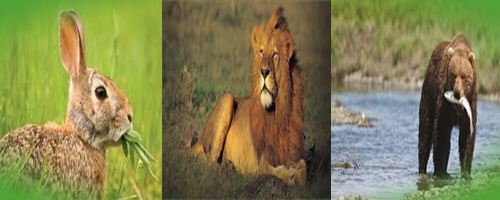Difference between Herbivores, Carnivores and Omnivores

Difference between Herbivores, Carnivores and Omnivores
There are many types of animals present around us. These animals are classified in three categories on the basis of their physical structure and eating habits. The animals are classified as herbivores, omnivores and carnivores. All these categories of animals are facilitating each another for their survival. These are being classified in order to understand their characteristics in a better way. Their way of taking energy is different as some depend on grass some on meat and some on both.
Herbivores
Herbivores are those animals that have to be dependent on grass for their survival. They only depend on plants. Their digestive system is capable of digesting all the grassy leaves and from those plants they are able to obtain fiber and other nutrients.
Carnivores
Carnivores are in a habit of eating other herbivores or meat. They have to depend on herbivores animals for their survival as they are unable to eat grass. Carnivores means “meat eater” in Latin. In carnivores there are two types of carnivores Facultative and obligate carnivores.
Omnivores
Omnivores are those animals which can consume both the grass as well as meat. In Latin word omnivore means “eater of everything”. But there are also some limitations of omnivores they cannot eat meat hard shell animals and they also unable to graze the grass.
Herbivores VS Carnivores VS Omnivores
Food:
Foods of herbivores are all the greenish shrubberies and vegetation. They totally depend on plants for survival
Carnivores use other herbivores as their food and meat.
Omnivores can eat both grass as well as meat.
Teeth:
Teeth of herbivores are not sharp but have front pointed front teeth.
Teeth of carnivores are sharp for chewing and grasping the meat. Carnivores have also pointed teeth.
Teeth of omnivores are not sharp they are either pointed front teeth.
Perspires:
In herbivores perspiration take place through the pores present on the body of herbivores animals.
In carnivores perspiration takes place through tongue in order to keep the body temperature normal.
Omnivores perspire through the pores present on body.
Salivary Glands:
Salivary Glands in herbivores are well developed as they help in grinding the fruits and grains.
In carnivores the salivary glands are not well developed. There are small salivary glands present in mouth of carnivores.
In omnivores the salivary glands are also well developed as there is a need of pre-digestion of food.
Acid in Stomach:
Hydrochloric acid present in herbivores stomach is 20 times less strong than hydrochloric acid present in carnivores’ stomach.
Strong Hydrochloric acid is present in carnivores’ stomach in order to digest the animal’s bones etc.
Acid present in omnivores is 20 times weaker than present in carnivores.
Examples:
Examples of herbivores include: Deer, Goat, Zebra and giraffe.
Lion, tiger, dog and vultures are some examples of carnivores.
Here are some examples of omnivore’s animals: bear, crows, fox and humans.
Conclusion
Every bird and animals present in the universe are giving benefits to each other. there is a life cycle which is working in this classification which means that for the survival of herbivores grass is important factor and similarly for the survival of carnivores are also necessary and for the survival of humans carnivores are important.


Very good
thanks dear
So perfect answer. People would love this site. Of course even I do love this site.
Really It is so good ❤️❤️🌸
Contanue ❣️❣️❣️❣️❣️
gracias
Humans cannot eat grass so why do you classify them as omnivores in contradiction of your own definition?
can you please tell us why?